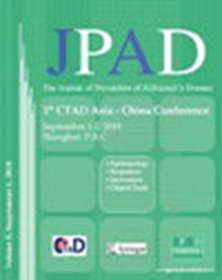阿尔茨海默病长期预防试验的新研究范式:安慰剂组模拟方法(PGSA):应用于NACC数据库的MCI数据
IF 7.8
3区 医学
Q1 CLINICAL NEUROLOGY
引用次数: 5
摘要
PGSA(安慰剂组模拟方法)旨在避免MCI患者安慰剂对照二级预防试验中典型的样本代表性问题和伦理问题。PGSA根据临床试验开始时建立的基线数据,使用数学模型来预测MCI患者组的量化结果分布。然后将这些预测分布与候选治疗中观察到的实际结果分布进行比较,从而替代伴随安慰剂组。在这里,我们研究了从ADNI 1*的MCI人群中开发的PGSA算法是否能够可靠地模拟来自更大的、独立选择的MCI受试者样本的复合神经心理结果的分布。方法采用国家阿尔茨海默病协调中心(NACC)提供的数据。我们纳入了1523例患有单域或多域遗忘性轻度认知障碍(aMCI)的患者,并在基线后至少进行了两次随访。为了加强分析并验证神经心理结果是否随时间而漂移,将NACC受试者样本分成3个大小相似的子样本。先前描述的用于复合神经心理测试电池(NTB)评分轨迹的PGSA算法适用于NACC中使用的测试电池。九种人口统计学、临床、生物学和神经心理学候选预测因子被纳入混合模型;利用该模型及其误差项模拟了自适应NTB的轨迹。结果1年、2年和3年后的经验观察数据和模拟数据的分布非常相似,在所有3个亚组中都存在一些对下降的高估。到目前为止,NTB轨迹最重要的预测指标是基线NTB评分。其他重要的预测指标是MMSE基线评分和时间与ApoE4和FAQ(功能能力)的相互作用。这些本质上与原始NTB分数的预测因素相同。结论一种包含少量基线变量(尤其是基线时的认知表现)的算法可以高精度地预测群体随后几年的认知能力下降轨迹。目前对NACC数据库中aMCI患者的3个独立亚组的分析支持PGSA纵向算法对NTB的有效性。在长期继发性阿尔茨海默病预防试验中使用PGSA值得考虑。本文章由计算机程序翻译,如有差异,请以英文原文为准。
A Novel Study Paradigm for Long-term Prevention Trials in Alzheimer Disease: The Placebo Group Simulation Approach (PGSA): Application to MCI data from the NACC database.
INTRODUCTION The PGSA (Placebo Group Simulation Approach) aims at avoiding problems of sample representativeness and ethical issues typical of placebo-controlled secondary prevention trials with MCI patients. The PGSA uses mathematical modeling to forecast the distribution of quantified outcomes of MCI patient groups based on their own baseline data established at the outset of clinical trials. These forecasted distributions are then compared with the distribution of actual outcomes observed on candidate treatments, thus substituting for a concomitant placebo group. Here we investigate whether a PGSA algorithm that was developed from the MCI population of ADNI 1*, can reliably simulate the distribution of composite neuropsychological outcomes from a larger, independently selected MCI subject sample. METHODS Data available from the National Alzheimer's Coordinating Center (NACC) were used. We included 1523 patients with single or multiple domain amnestic mild cognitive impairment (aMCI) and at least two follow-ups after baseline. In order to strengthen the analysis and to verify whether there was a drift over time in the neuropsychological outcomes, the NACC subject sample was split into 3 subsamples of similar size. The previously described PGSA algorithm for the trajectory of a composite neuropsychological test battery (NTB) score was adapted to the test battery used in NACC. Nine demographic, clinical, biological and neuropsychological candidate predictors were included in a mixed model; this model and its error terms were used to simulate trajectories of the adapted NTB. RESULTS The distributions of empirically observed and simulated data after 1, 2 and 3 years were very similar, with some over-estimation of decline in all 3 subgroups. The by far most important predictor of the NTB trajectories is the baseline NTB score. Other significant predictors are the MMSE baseline score and the interactions of time with ApoE4 and FAQ (functional abilities). These are essentially the same predictors as determined for the original NTB score. CONCLUSION An algorithm comprising a small number of baseline variables, notably cognitive performance at baseline, forecasts the group trajectory of cognitive decline in subsequent years with high accuracy. The current analysis of 3 independent subgroups of aMCI patients from the NACC database supports the validity of the PGSA longitudinal algorithm for a NTB. Use of the PGSA in long-term secondary AD prevention trials deserves consideration.
求助全文
通过发布文献求助,成功后即可免费获取论文全文。
去求助
来源期刊

Jpad-Journal of Prevention of Alzheimers Disease
CLINICAL NEUROLOGY-
自引率
7.80%
发文量
85
期刊介绍:
The JPAD « Journal of Prevention of Alzheimer’Disease » will publish reviews, original research articles and short reports to improve our knowledge in the field of Alzheimer prevention including : neurosciences, biomarkers, imaging, epidemiology, public health, physical cognitive exercise, nutrition, risk and protective factors, drug development, trials design, and heath economic outcomes.
JPAD will publish also the meeting abstracts from Clinical Trial on Alzheimer Disease (CTAD) and will be distributed both in paper and online version worldwide.
 求助内容:
求助内容: 应助结果提醒方式:
应助结果提醒方式:


